Research on the Cold Rolling Process, Microstructure and Properties of 305 Austenitic Stainless Steel Thin Strips
Abstract
:1. Introduction
2. Materials and Methods
2.1. Experimental Materials
2.2. Process Routes
2.3. Microstructure Observations, Tensile Testing and Hardness
3. Analysis of Rolling Test Results
3.1. Organizational Characterization
3.1.1. Microstructure Characterization
3.1.2. XRD Analysis
3.1.3. TEM Analysis
3.2. Characterization of Mechanical Properties
3.3. Magnetic Characterization
4. Analysis of the Results of Annealing Experiments
4.1. Characterization of Annealed Microstructure
4.2. Mechanism of Martensite Austenite Reversal
4.3. Annealed Mechanical Properties
5. Conclusions
- The 305 austenitic stainless steel used in this work has good comprehensive mechanical properties after cold rolling deformation. When the deformation amount is 70%, the yield strength can reach 1058 MPa and the tensile strength can reach 1273 MPa. After annealing, further rolling can make its strength reach 1321 MPa, which meets the strength requirements of production products.
- In the study of annealing experiment, it is found that the strength and plasticity of the experimental steel are the best after annealing at 850 °C for 30 s, thus this temperature is the most suitable temperature for annealing experiment.
- The experimental steel after annealing and rolling is annealed again. It can be seen from the experiment that annealing at 870 °C for 20 s can reduce its strength and meet the requirements of permeability. At this time, the yield strength is 1238 MPa and the permeability is below 1.02, which meets the production requirements of metal mask plate.
Author Contributions
Funding
Data Availability Statement
Acknowledgments
Conflicts of Interest
References
- Kuznetsov, P.V.; Stolbovsky, A.V.; Belyaeva, I.V. Quantitative Characterization of Grain Boundaries in Ultrafine-Grained Austenitic Stainless Steel by Cluster Analysis. Phys. Mesomech. 2023, 26, 415–433. [Google Scholar] [CrossRef]
- Sohrabi, M.J.; Mirzadeh, H.; Roostaei, M.; Renk, O.; Geranmayeh, A.R.; Mahmudi, R. Tailoring the microstructure and mechanical properties of superaustenitic stainless steel by cold rolling and recrystallization annealing. Arch. Civ. Mech. Eng. 2023, 23, 247. [Google Scholar] [CrossRef]
- Karanam, A.; Sarkar, A.; Nenzen, E.; Athavale, V.A.; Watson, M.; Bartlett, L.N.; Bichler, L. Microstructure Evolution and Austenitic Grain Refinement of Ti-Modified High Mn Steels during Solution Annealing Heat Treatment. Metall. Mater. Trans. 2024, 55, 389–402. [Google Scholar] [CrossRef]
- Olson, G.B.; Cohen, M. Kinetics of strain-induced martensitic nucleation. Metall. Trans. A 1975, 6, 791–795. [Google Scholar] [CrossRef]
- Hao, K.; Gao, M.; Wu, R. Cold rolling performance for austenitic stainless steel with equilibrium and non-equilibrium microstructures. J. Mater. Res. Technol. 2020, 9, 124–132. [Google Scholar] [CrossRef]
- Kessler, H.; Pitsch, W. On the nature of the martensite to austenite reverse transformation. Acta Metall. 1967, 15, 401–405. [Google Scholar] [CrossRef]
- Johannsen, D.L.; Kyrolainen, A.; Ferreira, P.J. Influence of annealing treatment on the formation of nano/submicron grain size AISI 301 austenitic stainless steels. Metall. Mater. Trans. A 2006, 37, 2325–2338. [Google Scholar] [CrossRef]
- Lee, B.Y.; Nam, J.W. Effect of Annealing Conditions on Microstructures and Mechanical Properties of a 5083 Al Alloy deformed at Cryogenic Temperature. Trans. Mater. Process. 2004, 13, 449–454. [Google Scholar]
- Rangaraju, N.; Raghuram, T.; Krishna, V.B.; Rao, K.P.; Venugopal, P. Effect of cryo-rolling and annealing on microstructure and properties of commercially pure aluminium. Mater. Sci. Eng. A 2005, 398, 246–251. [Google Scholar] [CrossRef]
- GB/T228.1-2021; Metal Materials Tensile Test Method at Room Temperature. People’s Republic of China National Standard: Beijing, China, 2021.
- Paul, S.; Tripathy, B.; Saha, R.; Bhattacharjee, P.P. Microstructure and texture of heavily cold-rolled and annealed extremely low stacking fault energy Cr26Mn20Fe20Co20Ni14 high entropy alloy: Comparative insights. J. Alloys Compd. 2023, 930, 167418. [Google Scholar] [CrossRef]
- Zheng, C.; Hu, L.; Zhen, Q.; Tang, Y.; Wang, Y.; Li, N.; Jiang, H. Low temperature mechanical behavior of fine- and ultrafine-grained 304 austenitic stainless steel fabricated by cryogenic-rolling and annealing. Mater. Charact. 2022, 191, 112084. [Google Scholar] [CrossRef]
- Salehi, M.; Eskandari, M.; Yeganeh, M. Characterizations of the Microstructure and Texture of 321 Austenitic Stainless Steel After Cryo-Rolling and Annealing Treatments. J. Mater. Eng. Perform. 2022, 32, 816–834. [Google Scholar] [CrossRef]
- Järvenpää, A.; Jaskari, M.; Kisko, A.; Karjalainen, P. Processing and properties of reversion-treated austenitic stainless steels. Metals 2020, 10, 281. [Google Scholar] [CrossRef]
- Yufeng, L.; Jie, S.; Junwei, W. Effect of Ni content on microstructure and mechanical properties for cold rolled 301L stainless steel. Ferroelectrics 2023, 607, 173–185. [Google Scholar]
- Heidari, R.B.; Eskandari, M.; Yeganeh, M. Microstructure and texture evolutions of 310S austenitic stainless steel after cryogenic rolling and subsequent annealing: X-ray and electron backscatter diffraction studies. J. Cent. South Univ. 2023, 30, 763–785. [Google Scholar] [CrossRef]
- de Lima, J.R.; Siqueira, G.O.; Neto, E.S.F.; Nakagomi, F.; Santos, D.B.; Renzetti, R.A. Microstructural Parameters of Cold-Rolled and Annealed Fe–24Mn–3Al–1Ni–2Si–0.06C Steel Obtained by X-ray Diffraction. Steel Res. Int. 2023, 95, 2300364. [Google Scholar] [CrossRef]
- Povolyaeva, E.; Shaysultanov, D.; Astakhov, I.; Klimova, M.; Zherebtsov, S.; Stepanov, N.D. Effect of Fe content on structure and mechanical properties of a medium: Entropy Fex(CoNi)100-xCr9.5C0.5 (x = 60 and 65) alloys after cold rolling and annealing. J. Alloys Compd. 2023, 959, 170469. [Google Scholar] [CrossRef]
- Shi, Y.; Zhang, A.; Liang, S.; Zhang, X.; Ren, S.; Liu, H.; Xu, D.; Yang, X.; Xing, Z.; Wang, L. Activation of multiple deformation mechanisms and HDI hardening devoting to significant work-hardening of gradient-dislocation structured TRIP steel. Mater. Sci. Eng. A 2024, 893, 146131. [Google Scholar] [CrossRef]
- Chatterjee, D. Effect of Cryorolling–Annealing and Bake-Hardening on the Microstructure and Mechanical Properties of AISI 301LN Grade Austenitic Stainless Steel. Metallogr. Microstruct. Anal. 2020, 9, 695–708. [Google Scholar] [CrossRef]
- Wang, L.; Kong, L.; Li, Y.; Wu, Y.; Su, H.; Su, Y.; Deng, B.; Liu, G.; Han, Z.; Zhang, Y.; et al. A novel (CoFeNi)82Ti5Al5V8 medium entropy alloy showing an ultra yield strength and a good ductility by L12 nanoparticles strengthening and dislocation strengthening. Mater. Sci. Eng. A 2024, 893, 146138. [Google Scholar] [CrossRef]
- Chen, S.; Tseng, K.-K.; Tong, Y.; Li, W.; Tsai, C.-W.; Yeh, J.-W.; Liaw, P.K. Grain growth and Hall-Petch relationship in a refractory HfNbTaZrTi high-entropy alloy. J. Alloys Compd. 2019, 795, 19–26. [Google Scholar] [CrossRef]
- Mangini, R.S.; Gomes, D.R.; Luiza MS, D.; Santos, D.B. Martensite reversion and strain hardening of a 2304 lean duplex stainless steel subjected to cold rolling and isochronous annealing at low temperatures. J. Mater. Res. Technol. 2022, 16, 168–186. [Google Scholar]
- Wu, H.; Niu, G.; Cao, J.; Yang, M. Annealing of strain-induced martensite to obtain micro/nanometre grains in austenitic stainless. Mater. Sci. Technol. 2017, 33, 480–486. [Google Scholar] [CrossRef]
- Lalé, M.; Malek, B.; Viguier, B. Martensite Decomposition and Ultrafine Grain Formation during Small Punch Creep Testing of Additively Manufactured Ti64. Metals 2023, 13, 1657. [Google Scholar] [CrossRef]
- Jungwan, L.; Hyojin, P.; Sujung, S.; Wung, B.J.; You, K.J.; Kyu, K.S.; Jae-il, J.; Seop, K.H. Impact of uneven distribution of grain characteristics on yield strength and martensitic transformation of as-hot-rolled medium-entropy alloys. J. Mater. Sci. Technol. 2024, 177, 234–245. [Google Scholar]
- Rosenauer, A.; Brandl, D.; Ressel, G.; Hönigmann, T.; Stadler, M.; Turk, C.; Gammer, C.; Wiessner, M.; Gamsjäger, E.; Stockinger, M.; et al. Multiscale in-situ observations of the micro- and nanostructure of a PH 13-8 Mo maraging steel during austenitization. Mater. Charact. 2024, 208, 113554. [Google Scholar] [CrossRef]
- Tan, D.; Fu, B.; Guan, W.; Li, Y.; Guo, Y.; Wei, L.; Ding, Y. Hierarchical Multiple Precursors Induced Heterogeneous Structures in Super Austenitic Stainless Steels by Cryogenic Rolling and Annealing. Materials 2023, 16, 6298. [Google Scholar] [CrossRef] [PubMed]
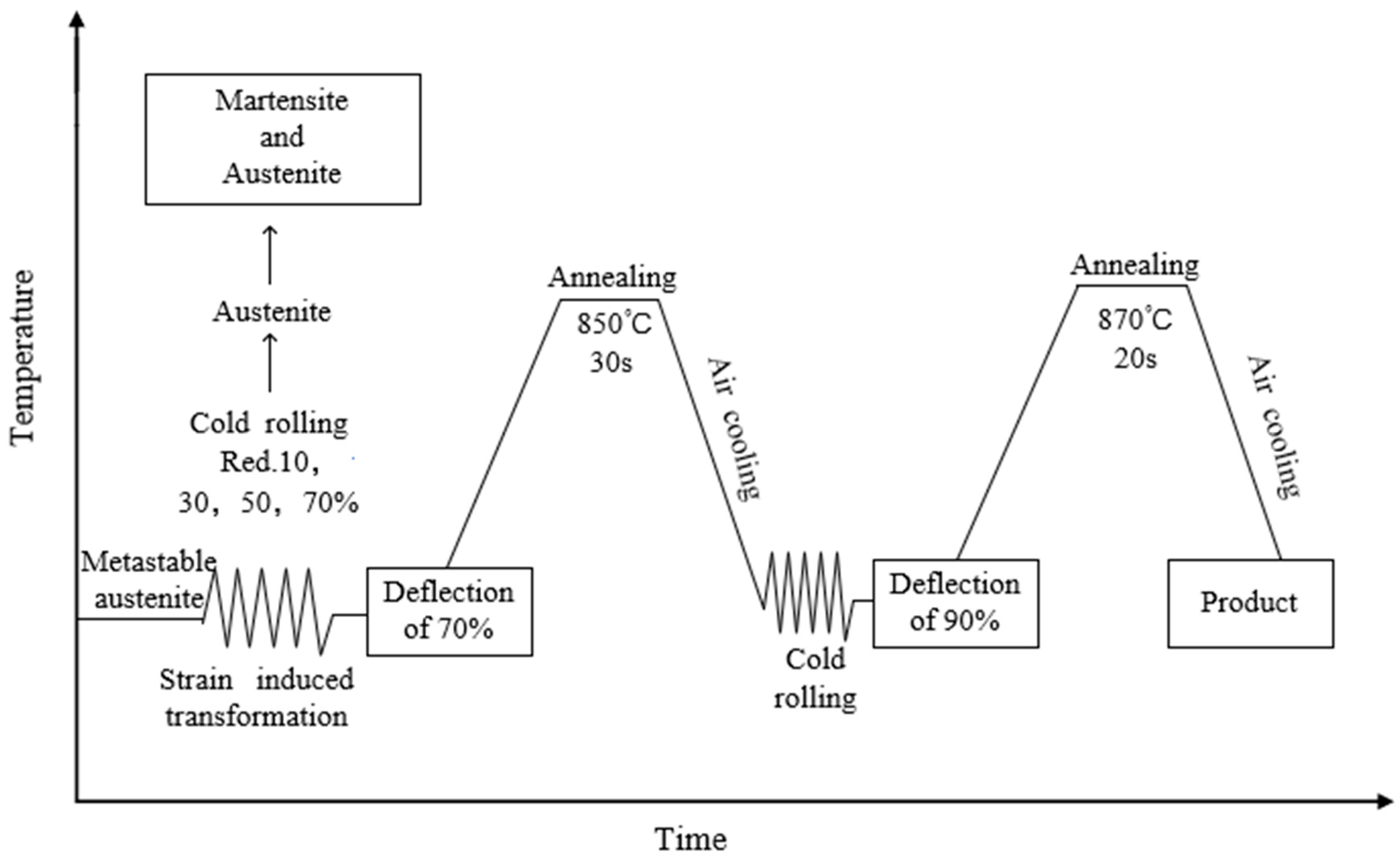
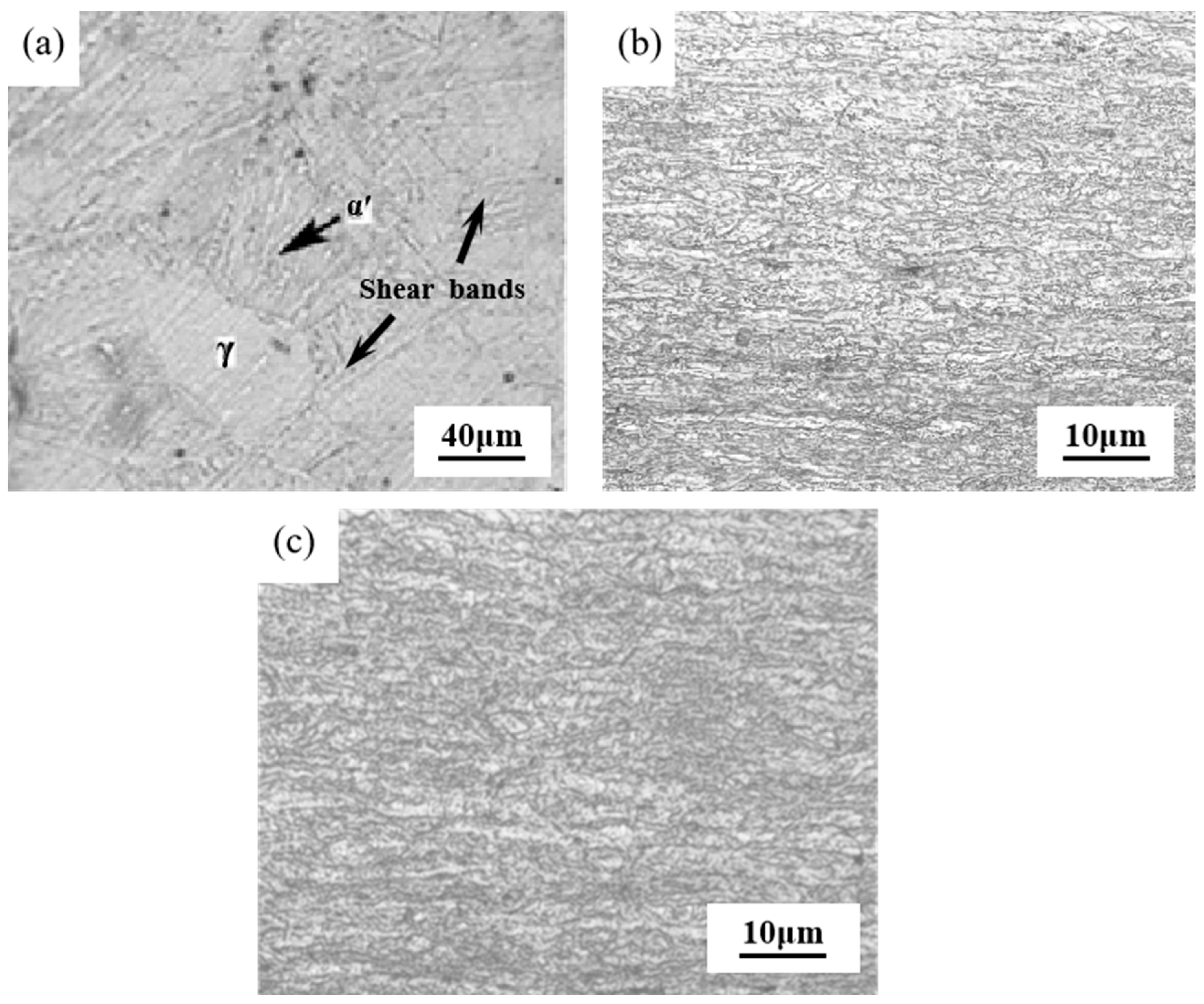
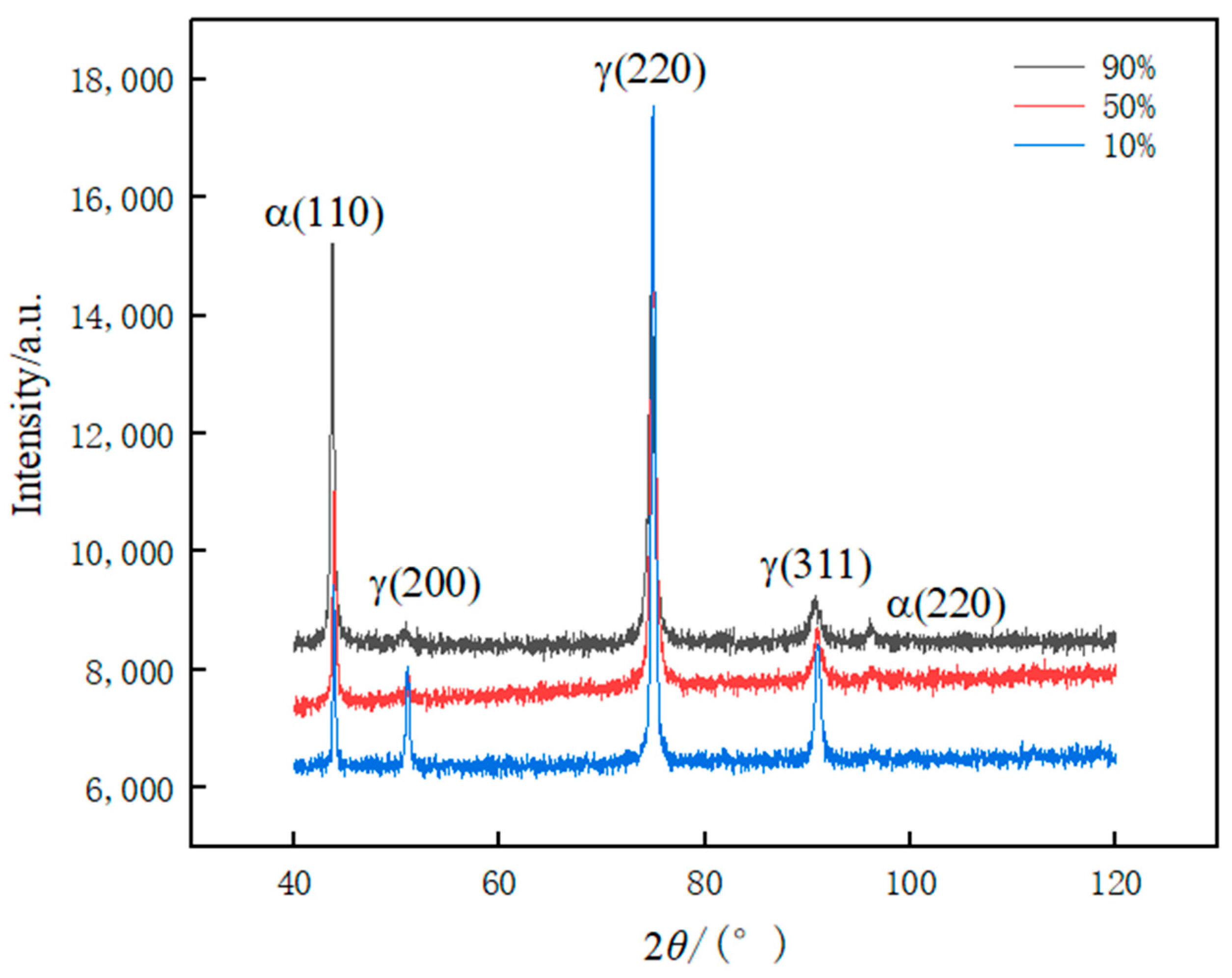
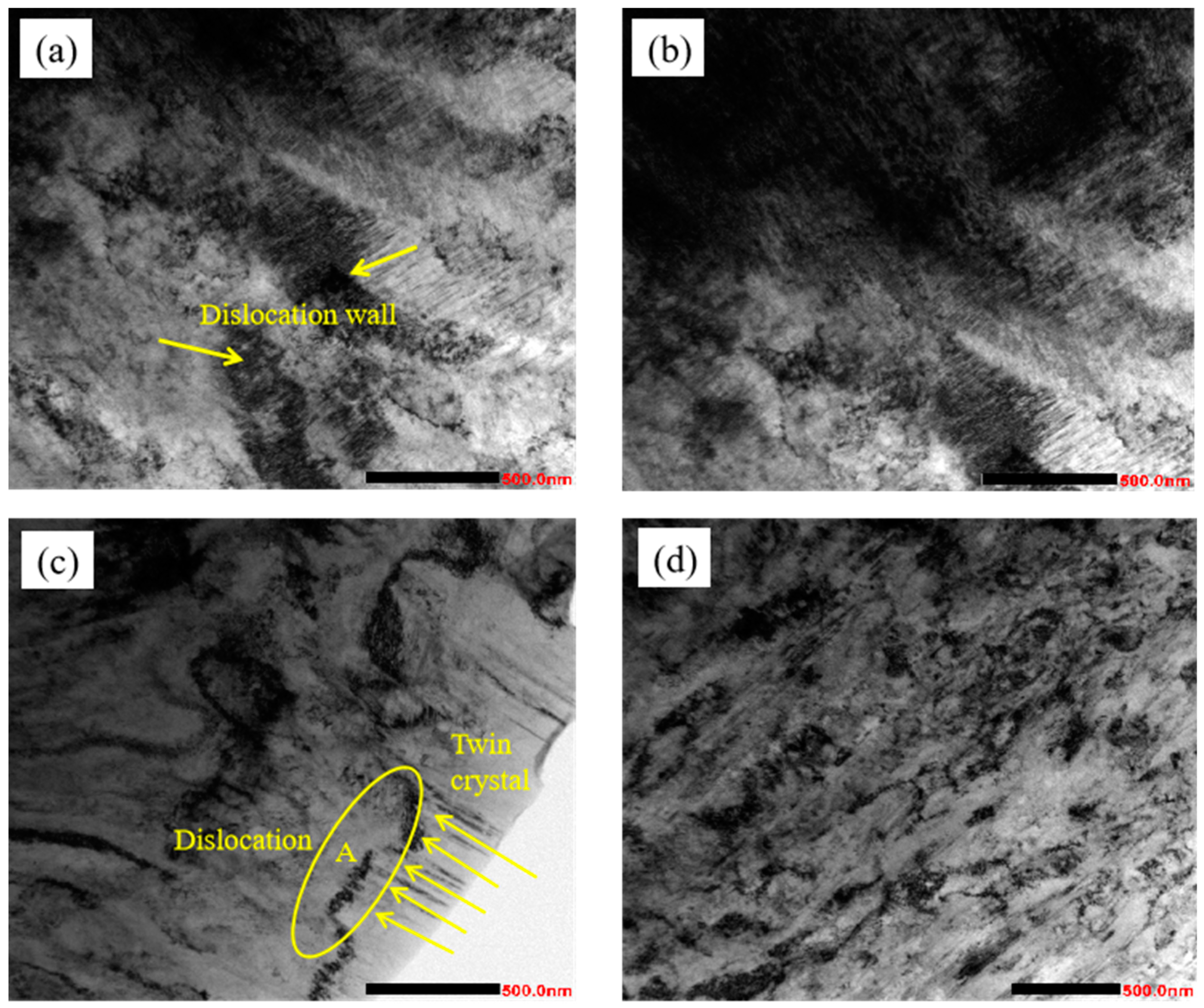
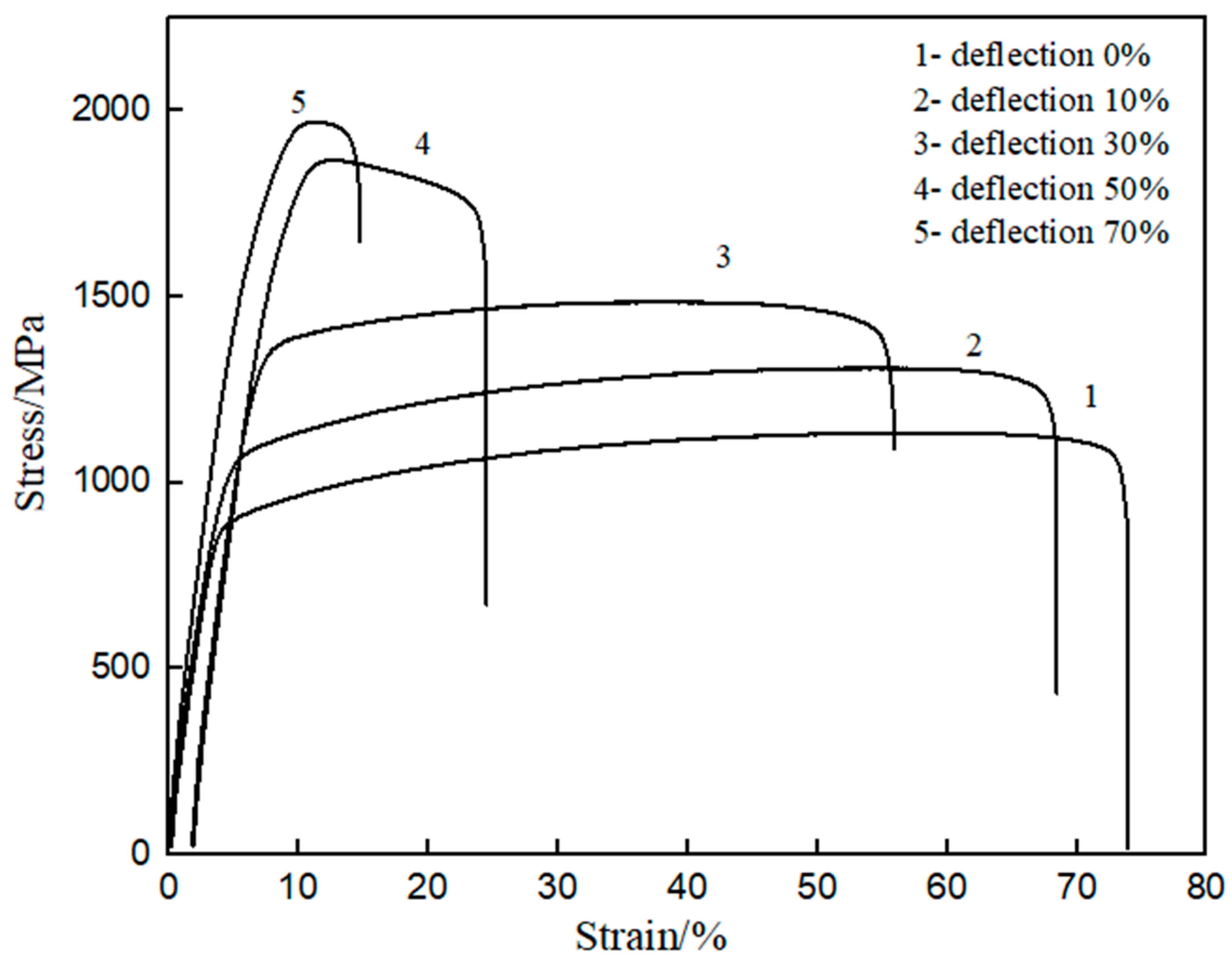
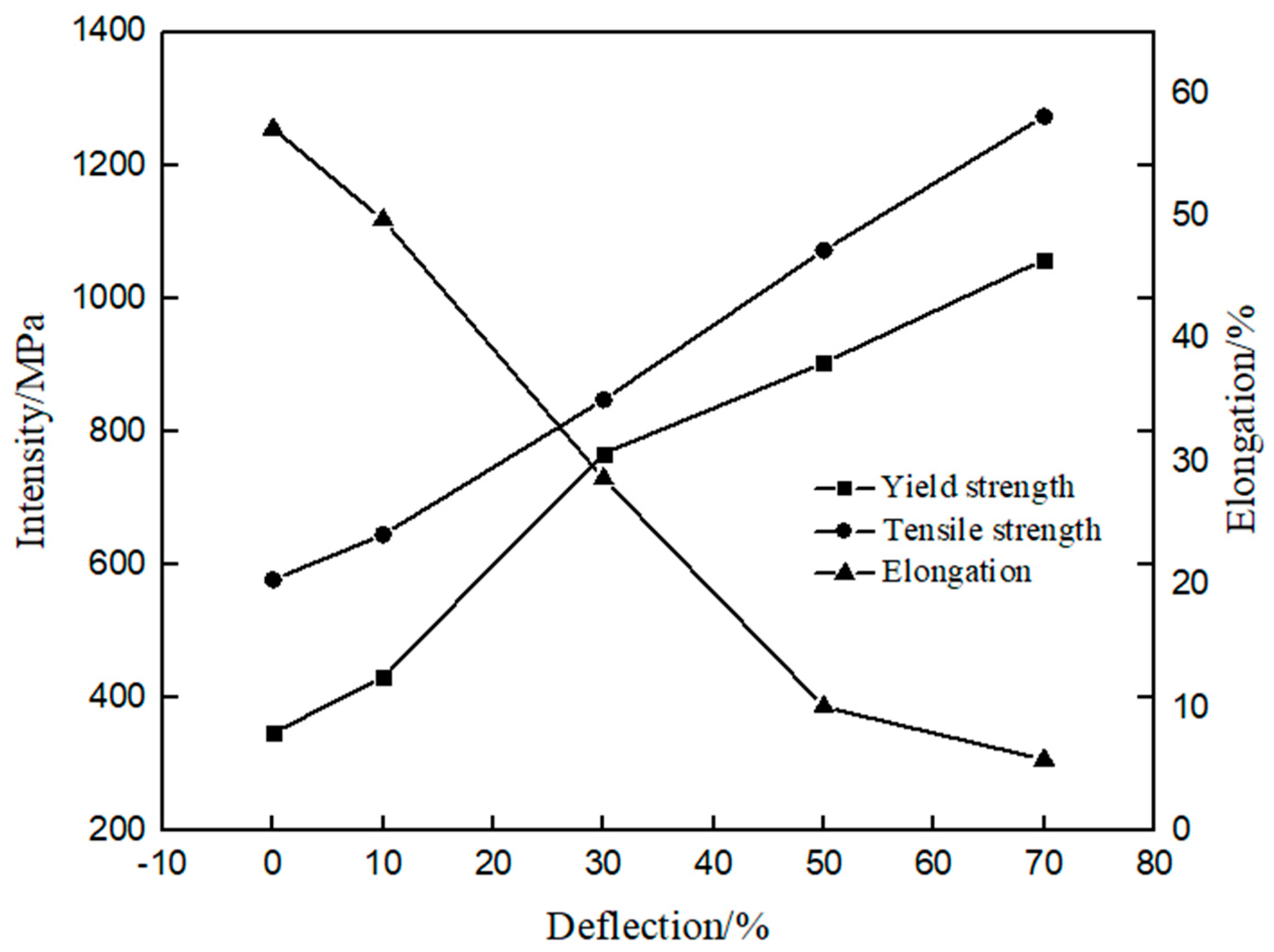
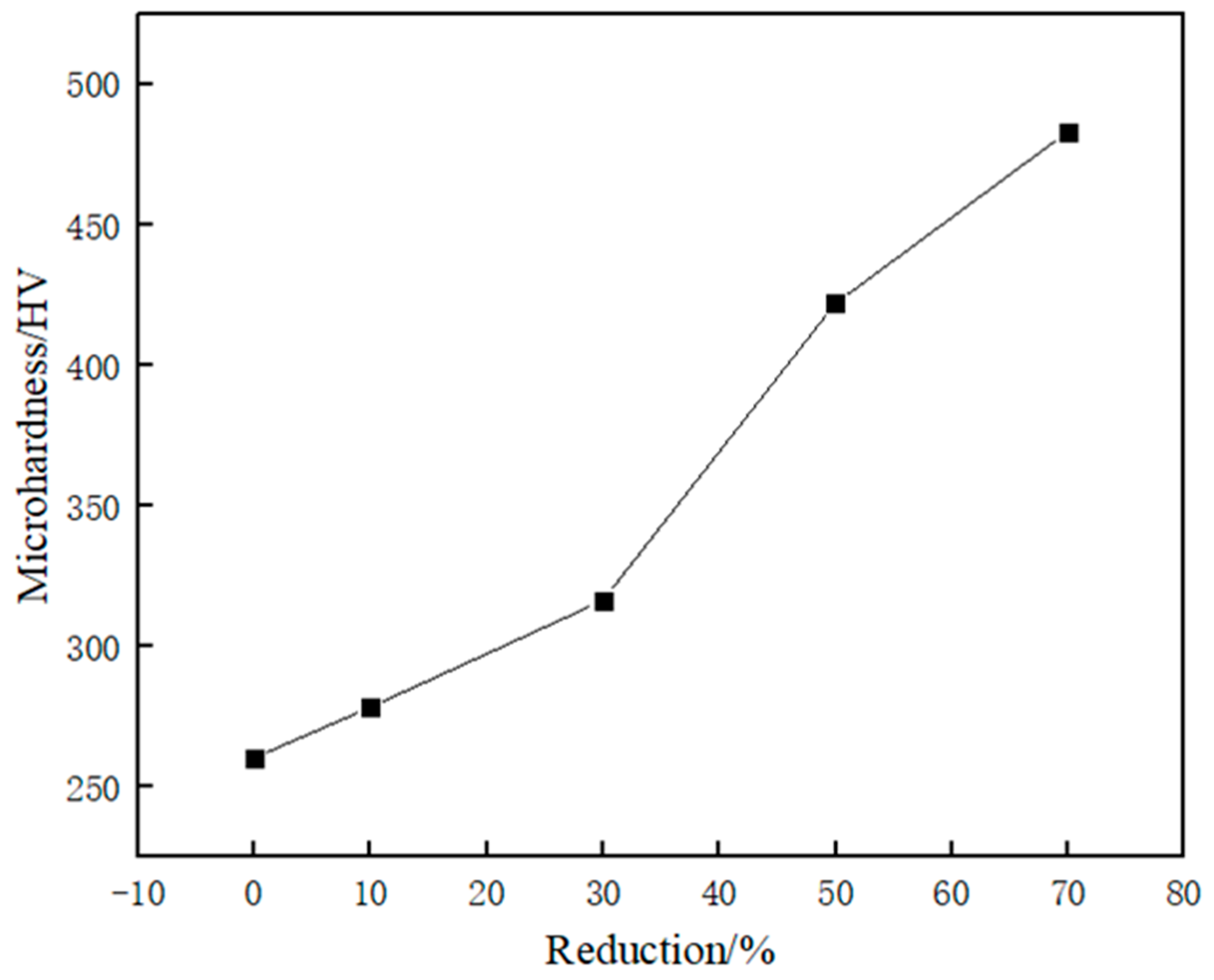
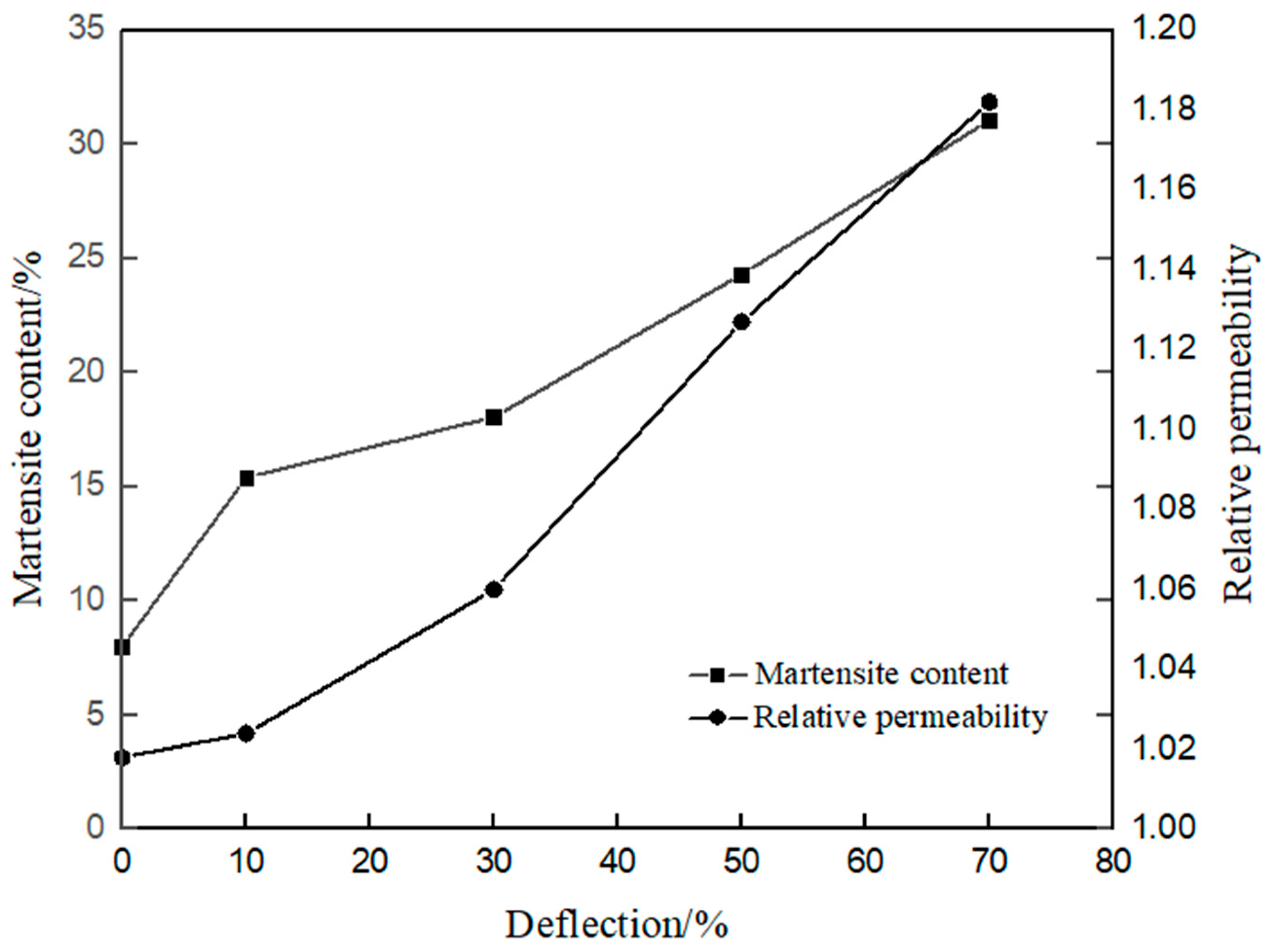
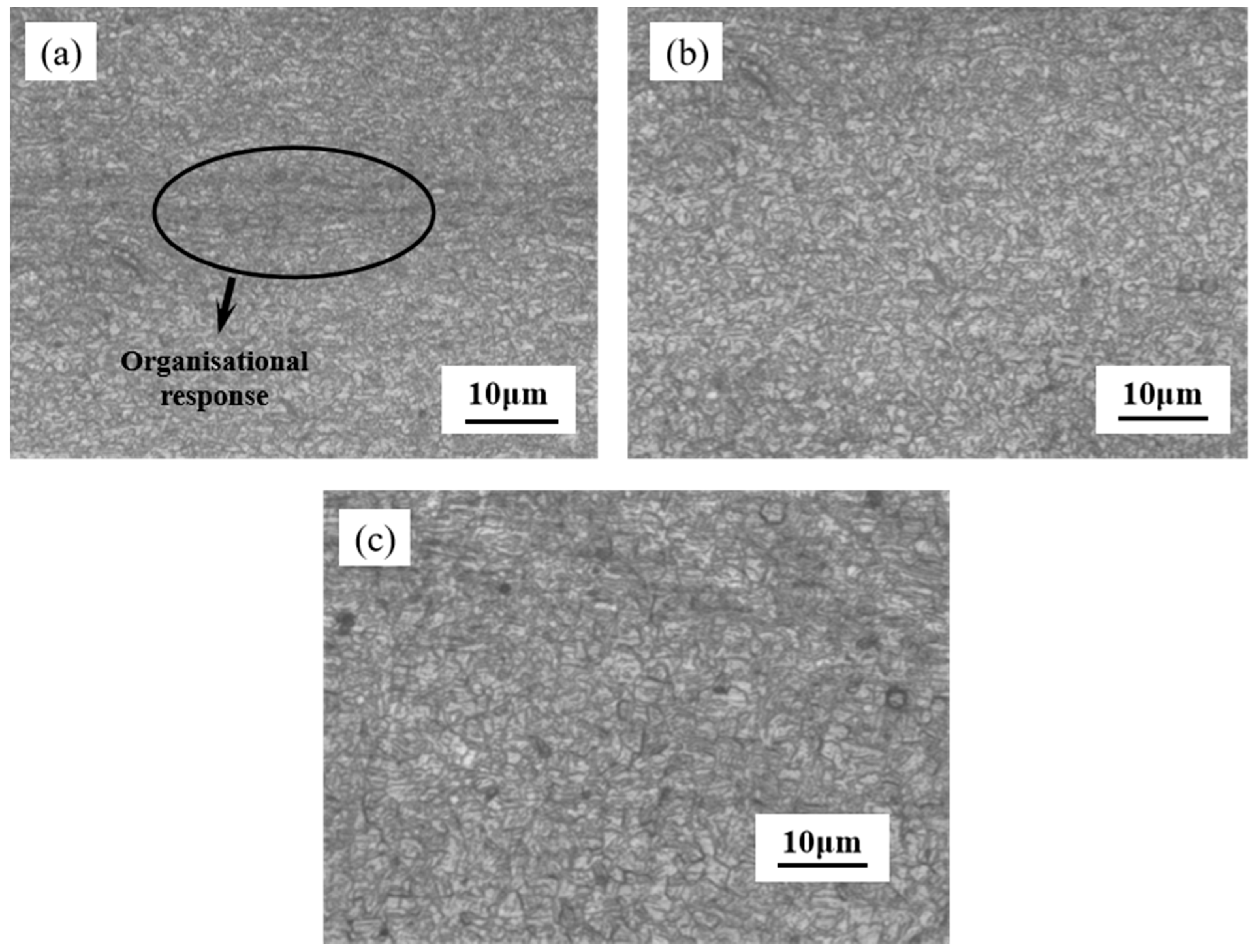
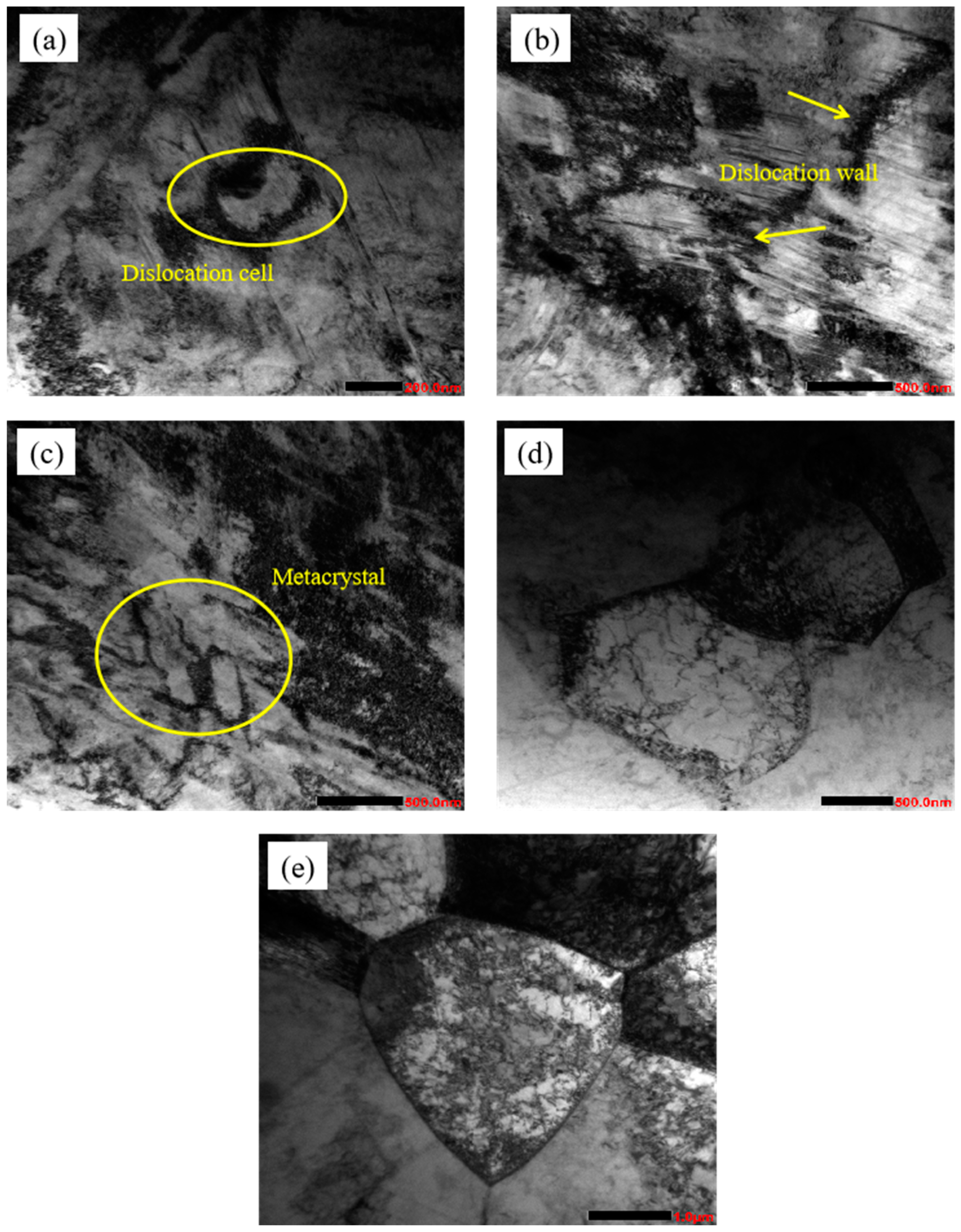
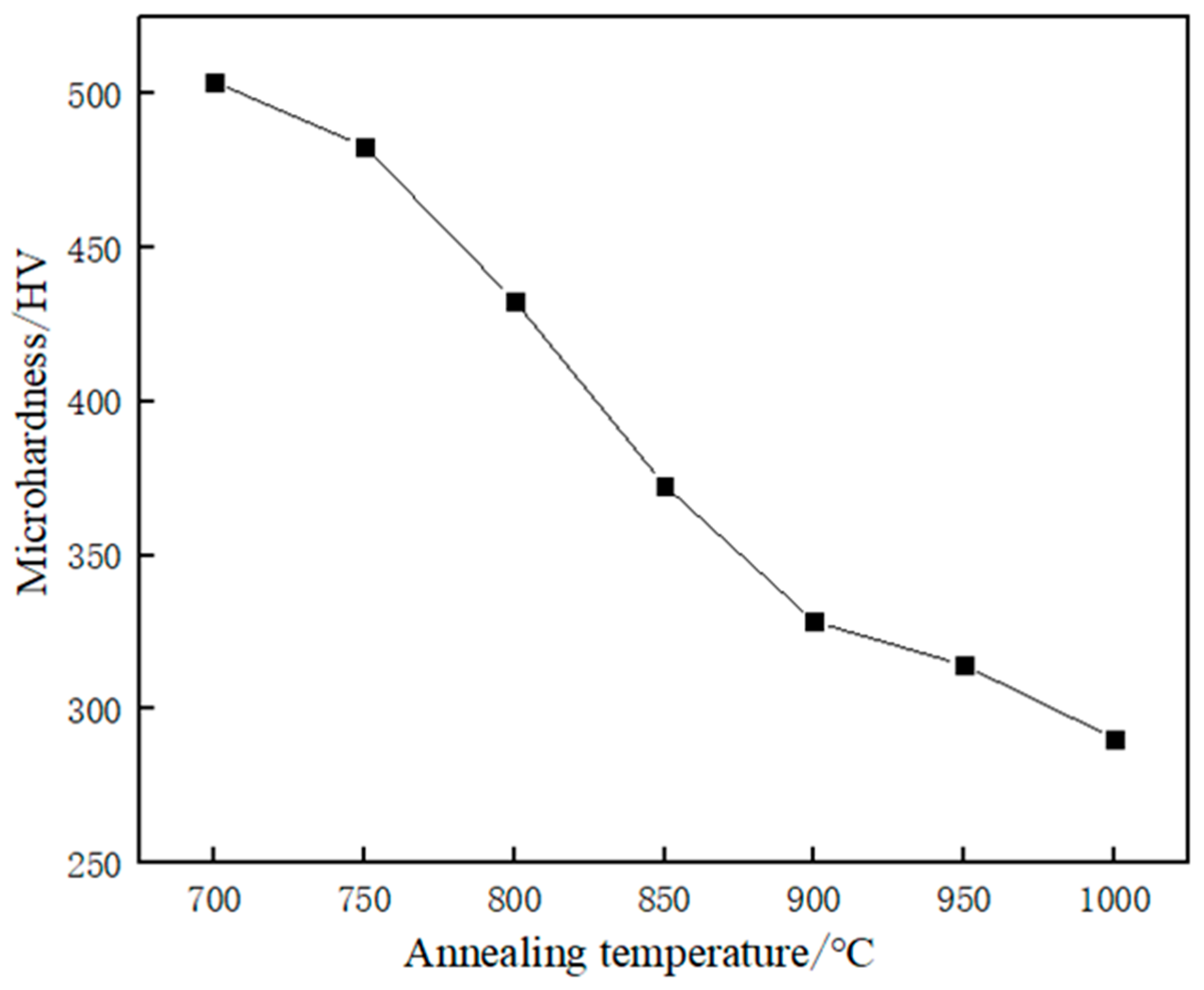
| Elemental | C | Si | Mn | P | S | Cr | Ni | N | Fe |
|---|---|---|---|---|---|---|---|---|---|
| Mass fraction | 0.07 | 0.51 | 1.05 | 0.032 | 0.003 | 16.15 | 6.1 | 0.06 | Bal |
| Deformation | 10 | 30 | 50 | 70 | 90 |
|---|---|---|---|---|---|
| Martensite volume fraction | 15.14 | 18.06 | 24.30 | 31.09 | 45.17 |
| Annealing Temperature, Time | Yield Strength (MPa) | Tensile Strength (MPa) | Elongation (%) | |
|---|---|---|---|---|
| 800 °C | 10 s | 1012 | 1203 | 8.37 |
| 800 °C | 30 s | 960 | 1132 | 15.76 |
| 800 °C | 60 s | 903 | 1050 | 21.32 |
| 850 °C | 10 s | 897 | 981 | 19.14 |
| 850 °C | 30 s | 852 | 932 | 43.98 |
| 850 °C | 60 s | 786 | 817 | 45.29 |
| 900 °C | 10 s | 702 | 733 | 23.50 |
| 900 °C | 30 s | 643 | 678 | 52.18 |
| 900 °C | 60 s | 598 | 612 | 57.23 |
Disclaimer/Publisher’s Note: The statements, opinions and data contained in all publications are solely those of the individual author(s) and contributor(s) and not of MDPI and/or the editor(s). MDPI and/or the editor(s) disclaim responsibility for any injury to people or property resulting from any ideas, methods, instructions or products referred to in the content. |
© 2024 by the authors. Licensee MDPI, Basel, Switzerland. This article is an open access article distributed under the terms and conditions of the Creative Commons Attribution (CC BY) license (https://creativecommons.org/licenses/by/4.0/).
Share and Cite
Wang, H.; Pan, L.; Chen, Y.; Cai, Z.; Zhao, Y.; Liu, G. Research on the Cold Rolling Process, Microstructure and Properties of 305 Austenitic Stainless Steel Thin Strips. Materials 2024, 17, 1250. https://doi.org/10.3390/ma17061250
Wang H, Pan L, Chen Y, Cai Z, Zhao Y, Liu G. Research on the Cold Rolling Process, Microstructure and Properties of 305 Austenitic Stainless Steel Thin Strips. Materials. 2024; 17(6):1250. https://doi.org/10.3390/ma17061250
Chicago/Turabian StyleWang, Huanhuan, Lifang Pan, Yong Chen, Zhihui Cai, Yongshun Zhao, and Guangming Liu. 2024. "Research on the Cold Rolling Process, Microstructure and Properties of 305 Austenitic Stainless Steel Thin Strips" Materials 17, no. 6: 1250. https://doi.org/10.3390/ma17061250




